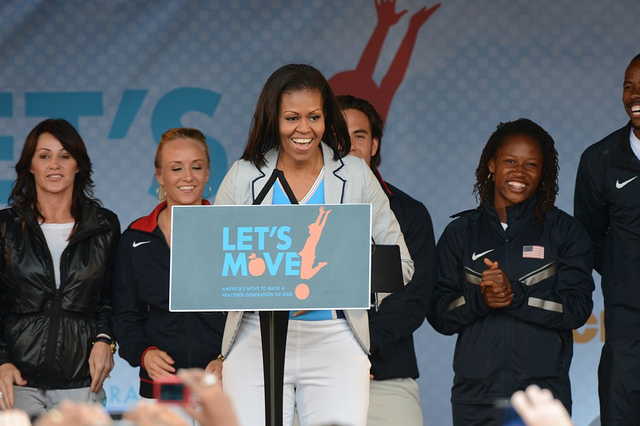Image courtesy US Army IMCOM/Flickr
By Laura Cipullo, RD, CDE, CEDRD
How Let’s Move Can Help Our Kids — and How it Can Be Improved
It’s hard not to like Michelle Obama. She’s intelligent, has a good sense of humor, and is a great mom who is generally concerned about our kids. That’s why she’s created the Let’s Move program, an initiative to help make this and future generations of kids healthier by encouraging them to eat nutritious foods and increase physical activity.
Overall, I think the program has its strengths and weaknesses. In this blog post, I want to take a closer look at the positives, and also at what could be improved.
Focus on improving health, not losing weight
If you click around the Let’s Move website, you’ll notice there’s a focus on the words “obesity” and “overweight,” and a connection between these attributes and illness: “If we don’t solve this problem [of obesity and being overweight],” the Let’s Move site says, “one third of all children born in 2000 or later will suffer from diabetes at some point in their lives. Many others will face chronic obesity-related health problems like heart disease, high blood pressure, cancer, and asthma.”
But this is not necessarily true. There is an alternate movement out there called Health at Every Size, which says that it is possible to be “overweight,” while still being healthy.
When you focus on a child’s weight, you make that child preoccupied with the way his or her body looks — a behavior that could lead to an eating disorder, or disordered eating. We want to encourage our children to adopt healthy habits, but not with the goal of losing weight. The goal should be health itself and feeling good, and that’s what we should be imparting to our kids.
The site also has a section on reducing fat and sugar. This may set children up for seeing foods as “good” and “bad.” The truth is there is nothing terribly wrong with fat or sugar. Children only need to be taught that some foods are eaten regularly and others are eaten sometimes.
Where the Let’s Move Program gets it right
That being said, there is much that is positive about this program.
The Healthy Families section offers some helpful tips, such as:
- During family meals, concentrate on eating and enjoying food and each other
- A bowl of fruit or carrot sticks on the kitchen table can encourage healthy eating
- You can serve fresh, frozen, and canned fruits and vegetables; all are fine
- Incorporate vegetables into dishes, like adding peas to rice, or cucumbers to a sandwich
- Don’t force kids to clean their plates if they are full
- Eating with your child is a chance to illustrate positive behavior
The Get Active section has great ideas on getting children to move and offers reasonable goals for children, families and the community. Children, they suggest, should move for about an hour a day. Schools should support this by increasing physical activity within the school schedule, and politicians and community heads should make parks, playgrounds and neighborhood centers inviting for children and their parents, while also offering fun and cheap physical activity programs. It also offers the Presidential Active Lifestyle Award for those who meet their goals.
Perhaps the most valuable part of the site is the Take Action for Kids PDF.
It invites kids to move every day, try new foods, drink water, do jumping jacks (or other fun activities) and help with dinner.
These are just a few of the program’s highlights. I encourage you to explore more of Let’s Move by heading to the site and checking it out for yourself!








